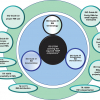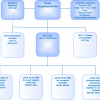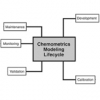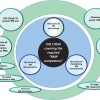Peter J. Jenks
the Jenks Partnership, Newhaven House, Junction Road, Alderbury, Salisbury, Wiltshire SP5 3AZ, UK. E-mail: [email protected]
At the beginning of October 2008 I took part in an International Symposium on Pharmaceutical Reference Standards, organised by the European Directorate for the Quality of Medicines & HealthCare (EDQM) and held between 9 and 10 October 2008 in Strasbourg, France. For those interested, the proceedings can be found on the EDQM Website (http://www.edqm.eu/site/Download-527.html). They are a number of pdf files towards the bottom of the very long page...
The meeting was stimulating and a number of the presentations, in particular those by Dr William F. Koch, Chief Metrology Officer for the United States Pharmacopeia (USP) and Dr Steve Wood, LGC Limited (UK), resulted in considerable, and sometimes heated, debate. But sitting in the audience I began to feel that somehow I’d experienced a time shift: the debate was strangely familiar, even down to the arguments opposing the topics that had been presented. How could this be? Well, the speakers were introducing the concept of uncertainty in chemical measurement to a group who were not really sure they needed to know about uncertainty, as applied to their chemical measurement world and clearly for some the perceived consequences of introducing uncertainty to pharmaceutical analysis was a real concern.
My feeling that I’d been there before was no illusion: in what is now quite a long career I’ve found myself involved with exactly the same debates before: first in the mid 1970s, then later in the early 1990s. How did that happen and why does the simple concept of uncertainty in chemical metrology seem to need re-introducing on a regular basis?
I was first introduced to the concept of chemical metrology back in 1975 when, as a basic grade biochemist at Worcester Royal Infirmary, I was reading for a Masters in Chemical Pathology at Birmingham University. The course was the brainchild of Professor Tom Whitehead, the first Professor of Clinical Chemistry at Birmingham University, and the content included, for the time, some quite radical concepts: method validation, on-going quality control, both between and within batch and routine externally organised proficiency testing and the calculation and application of uncertainty to results.
Tom was a remarkable person: he died in 2005, age 82 after a long and very influential life. As one of the then junior lecturers on the course in 1975, Dr Larry J. Kricka wrote late in 2005 in Tom’s obituary,1 “Tom was a visionary whose career spanned a period in our profession when laborious manual assays for a few analytes gave way to highly efficient testing for large panels of tests aided by automation and computing. At the same time, he was instrumental in setting in place a quality-control scheme. This interest in external quality assessment was advanced by a grant in 1969 from the Ministry of Health and was used to develop the National Quality Control Scheme for Clinical Chemistry.”
This two-year project evolved into the United Kingdom National External Quality Assessment Service, which has evolved into a significant business, offering proficiency testing services world wide. During this period of great change in the way clinical chemistry was delivered very considerable education of the clinicians was needed: I recall that at the hospital I worked in the results from the Clinical Chemistry lab were not shown with an uncertainty: they went out to the wards as a number and a “normal range”, so the clinicians would feel comfortable.
Fast forward to the early 1990s! In 1976 the Seveso disaster occurred: an industrial accident started at approximately 12:37 pm 10 July 1976, in a small chemical manufacturing plant approximately 25 km north of Milan in the Lombardy region in Italy. It resulted in the highest known exposure to 2,3,7,8-tetrachlorodibenzo-p-dioxin (TCDD) in residential populations and resulted in numerous scientific studies and standardised industrial safety regulations, including in the EU, Council Directive 96/82/EC of 9 December 1996 on the control of major-accident hazards involving dangerous substances aimed at improving the safety of sites containing large quantities of dangerous substances. It is also known as the Seveso II Directive.
Between 1976 and 1996 there was an enormous increase in the analysis and monitoring of all aspects of the environment for pollutants, organic and inorganic. Perhaps more significantly, ISO 17025 arrived and was adopted by most regulators as the Standard to which analytical laboratories must be accredited. In 1990 I started working for a small, and little known, German company: Promochem GmbH. By dint of good connections, hard work and the considerable foresight of one of its founders, Ken Jenkins, Promochem found itself as the major supplier of the certified reference materials needed by the labs undertaking much of this research and then routine testing. Over the years Promochem grew, became LGC Promochem and is now LGC Standards.
Whilst the clinical chemists got to grips with metrology and the environmentalists and others worked through the consequences of ISO 17025 the pharmaceutical industry carried on much as it always had done: going its own way. The pharmaceutical industry does things differently: perhaps due to the very early adoption of regulatory systems and government licensing of products. The system has, for many years, been seen to work and with a very self contained industry there was no incentive, let alone enthusiasm, for change. In the late 1990s the industry started to out-source more and more services, including analytical testing. Many of the contracted labs were working in an ISO 17025 Accredited environment and struggled with the differences between “chemical good manufacturing practice” (cGMP) and the requirements of ISO 17025. The differences are many, but mostly in detail. For example, pharmaceutical RS do not have a Certificate of Analysis and Assay standards quote an “Acceptable Range”, not a value plus uncertainty. But slowly and steadily pressure from the “ISO World” has mounted.
In August this year USP was granted accreditation to the International Organisation for Standardisation (ISO) Guide 34 for reference material production. This made them an internationally accredited producer of Certified Reference Materials (CRM) and extended their prior ISO 9000 certification and 17025 accreditation.
On 24 September 2008, only two weeks before the meeting at the EP, USPC surprised many by releasing their first CRM under the new Accreditation: Dextromethorphan Hydrobromide. At the meeting it was described by Koch as “a milestone for USP since it represents our first Certified Reference Material”, he went on to say that “by releasing the first pharmaceutical CRM from any pharmacopeia USP is maintaining the high levels of scientific and metrological leadership that customers, regulators and practitioners around the world have come to expect from us”. In discussion after the presentation he indicated that about a third of the more than 2500 USP RS would end up as CRMs and for some of the high demand units they would not wait until a new lot was released, but go and re-certify existing stocks.
Their press release, issued on 24 September, stated that the new CRMs are intended to provide pharmaceutical manufacturers with a new class of reference standard that ensures improved information for measurements of their products when meeting requirements set forth in the United States Pharmacopeia–National Formulary (USP–NF). Each CRM comes with a Certificate of Analysis containing data on certified property value, uncertainty value and for the first time an expiration date (period of validity), all of which aim to produce a higher level of trueness and traceability in the measurement of product and ingredient specifications. This is all good stuff, but an informed source, close to USPC, stated that “The concern the industry ought to have, and I’m not sure they are totally aware of it yet, is that USP intends to use uncertainty as acceptance criteria for labs qualifying pharmaceuticals. This will be difficult and be a heavy burden on the industry, both from the learning curve and their ability to actually meet tighter acceptance criteria.”
So, the pharmaceutical industry, at least the US part of it, is going to be dragged, (from the reaction of some Qualified People at the EP meeting, perhaps kicking and screaming), into the mainstream ISO Chemical Metrology world.










